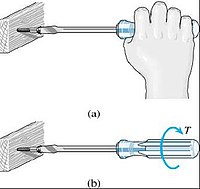
Photo from wikipedia
The issue of tool adoption has been the subject of many investigations, which focus either on acceptability (evaluating intention to use, a priori) or acceptance (evaluating real tool use, a… Click to show full abstract
The issue of tool adoption has been the subject of many investigations, which focus either on acceptability (evaluating intention to use, a priori) or acceptance (evaluating real tool use, a posteriori). There are many criteria in the literature explaining why a tool is accepted or rejected by users, but behavioral observations are rare. This work aims to study the relationship between acceptability and acceptance and to find out if there is a hierarchy between the criteria that lead a user to use a particular tool. We exposed participants to eight xylophones varying according to three criteria: Ease of use, Utility, and Aesthetics. We assessed acceptability and judgment of participants about xylophones with questionnaires, based on tool use observation in a video session, and after a short-term use (Experiment 1); we also measured acceptance after long-term use of five sessions during which participants learned to play xylophone (Experiment 2). The results suggested that previous exposure to the tool influenced the judgment of the user, indicating a difference between acceptability and acceptance and between observation and use of a tool. The results also indicate differences in the hierarchy of criteria. In the acceptability phase, user judgments are guided by Ease of use. However, during the acceptance phase, the Utility criterion has the greatest influence, whether in terms of tool preference, or time spent using tools.
Journal Title: Cognitive processing
Year Published: 2021
Link to full text (if available)
Share on Social Media: Sign Up to like & get
recommendations!